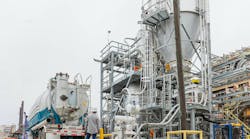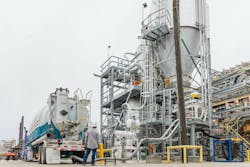ORLANDO -- Exxon Mobil Corp. isn't bidding farewell to fossil fuels, but the company is executing a strategy that blends traditional oil and gas activities with low-carbon solutions, said a company executive during the ARC Advisory Group Forum on Feb. 6.
Wade Maxwell, vice president of engineering at Exxon Mobil Technology and Engineering Co., commented on the company’s efforts during his keynote address at the technology conference held annually in Orlando.
He spent the bulk of his half-hour speech focused on the role of carbon-capture solutions over renewables, such as wind or solar. This includes several initiatives underway at Exxon Mobil, many taking place at its Baytown, Texas, operations.
Clearing the Air
Carbon capture has the potential to reduce industrial emissions by approximately 90%, Maxwell said.
Exxon Mobil announced three agreements in 2023 to capture and store CO2 from third parties, including fertilizer, steel and industrial gas producers, on the U.S. Gulf Coast. The first of those projects will begin in 2025, Maxwell said.
He also alluded to the company’s July 2023 acquisition of CO2 pipeline operator Denbury for $4.9 billion as another key development in its carbon-capture and storage efforts.
Direct air capture, or DAC, is another technology that Maxwell highlighted as a potential game-changer for industrial emissions. This technology overcomes the constraints of conventional carbon-capture methods by extracting CO2 directly from the atmosphere from any location, not just at the point of emissions.
The primary challenge with DAC is cost, Maxwell said. Exxon Mobil completed construction of a DAC pilot plant at its Baytown complex late last year. The company is working with researchers and engineers to commercialize DAC and lower the technology cost, Maxwell said.
Shades of Clean Hydrogen
Exxon Mobil currently produces about 1 million tons of hydrogen a year. The company is working to develop new technologies to develop lower-cost hydrogen.
Another Baytown project involves the development of a blue hydrogen facility, which could be the largest in the world when completed, Maxwell said.
“This facility will create hydrogen from natural gas,” he explained. “The capacity we’re designing for is about 1 billion cubic feet of hydrogen per day. That’s enough energy to power one-and-a-half million homes.”
The company plans to capture 98% or more of the CO2 from the hydrogen facility, he added.
Plastics and Batteries
In November, Exxon Mobil announced plans to become a leading lithium producer for electric vehicle batteries, with the launch of its initial production phase at a field in southern Arkansas. The company is using a direct lithium extraction process that is two-thirds less carbon intensive than hard-rock mining, Maxwell said. The technology leverages the company’s existing oil and gas development expertise in subsurface exploration and chemicals production. The company expects production to begin at the site in 2027.
The company also is expanding efforts around plastics reuse with an “advanced recycling” initiative.
“It doesn’t limit itself to materials you can ground up and melt into recycled plastic,” Maxwell said. “The process actually converts waste plastic back to its molecular building blocks that we can then use to manufacture new plastics.”
The company opened an advanced plastics recycling facility in Baytown in 2022 that has the capacity to process about 80 million pounds per year of plastic waste that could result in new materials.
The Role of Digitalization
Digital technologies, including artificial intelligence (AI), play a key role in low-carbon energy solutions, Maxwell said.
“When you think about the challenges of the energy transition, I think AI is foundational to the technology suite,” Maxwell said.
Exxon Mobil has deployed AI to create subsurface models and is using it to optimize carbon sequestration at injection sites. Generative AI is another technology in the mix, helping the company leverage data more effectively.
A digital-twin initiative has the potential to deliver further efficiencies by bringing together virtual assets across the organization.
Maxwell characterized it as a “standards-based, open, secure, interoperable platform” that democratizes data across the organization.
“It is a foundation for speed and scale,” he said.




